How To Nymph For Steelhead: FULL ARTICLE
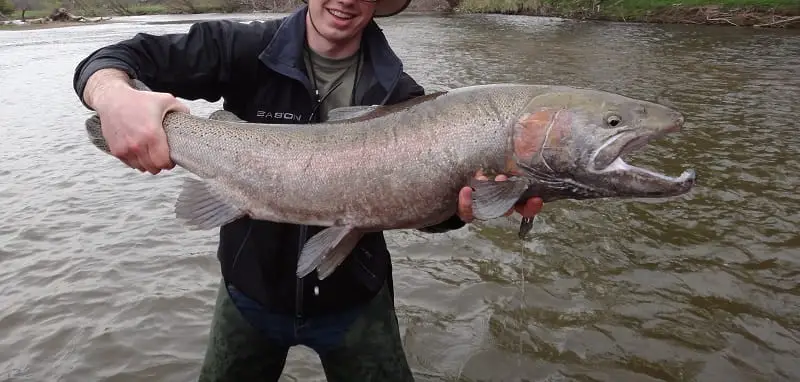
I have been teaching fly fishermen how to effectively nymph for steelhead for over twenty years now. As an expert at this method, I can easily say that nymphing is the most effective way to catch steelhead with a fly rod, but only if you do it properly.
I use methods that I’ve learned from veteran guides and from some of the world’s best competition anglers. There are three effective ways to nymph for steelhead, and I will explain them here.
Nymphing for steelhead is when you present your fly below the surface in a way that naturally imitates the steelhead’s natural food sources.
The three most effective ways to do this are:
- Indicator Nymphing: This method uses a bobber-like device known as a strike indicator which helps detect a bites. Good anglers will also utilize the indicator to present the fly better which in turn means more hook-ups.
- Suspension Nymphing: This method is similar to Indicator nymphing except with a shorter leader, which enables the indicator to suspend the fly off the bottom. This can be superior and allows the angler to get a better presentation and bite detection.
- Euro Nymphing: This is a tight-line competition method that was initially designed for trout fishing. However, in certain situations, it is the most effective way to catch steelhead.
What To Consider If You Want To Nymph Well
- Using these methods properly with the proper leader setup and the proper presentation is critical. Based on my experience after teaching thousands of anglers how to nymph for steelhead, most anglers do not nymph very well.
- I will use different nymphing methods at different times and under different types of river conditions. It’s important that you understand when to use each method if you want to maximize your success.
- The best flies to use when steelhead nymphing would be imitations of aquatic insects, fish eggs, or worms. However, even a great fly is nearly useless if you don’t present them properly.
- Nymphing for steelhead is often the most effective way to fly fish for steelhead on mid-sized rivers that are 120 feet wide or smaller. Rivers or creeks from 10 to 50 feet wide are my favorite for nymphing.
- Long fly rods of ten to eleven feet are best for nymphing.
Choosing The Right Nymphin Method
The method of nymphing that I use when fishing or guiding for steelhead will depend on a few factors, such as:
- Size of the spot I’m fishing.
- The distance that I need to cast to get the fly to the fish while being able to present the fly properly.
- The depth of the spot.
- The speed of the spot that I want to fish.
Anglers that know when to change their nymphing method based on the conditions in front of them will be able to catch a lot more steelhead. I will discuss each method and when to use them below.
Best Steelhead Fly Rod, Reel, and Fly Line
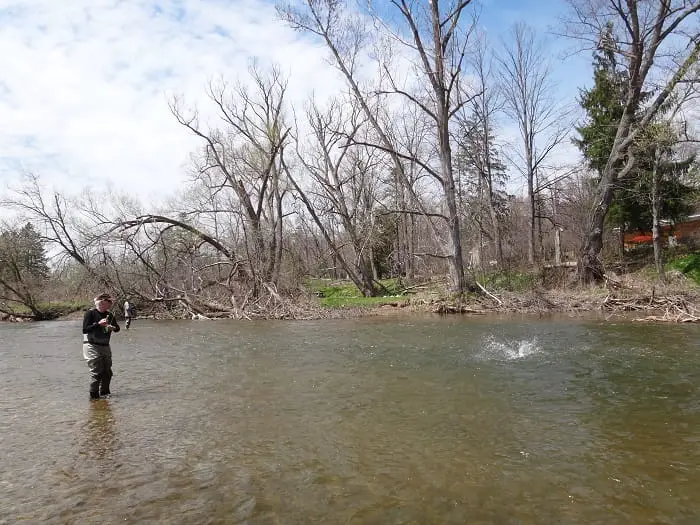
The best steelhead fly rods for nymph fishing are the longer 10 to 11 foot fly rods in the 7 or 8 weight size. Match your fly rod with a suitably sized fly reel that has a large arbor spool and an enclosed drag system that is smooth, and you’ve got the perfect setup for nymphing.
The best rod that I recommend to all my clients for steelhead nymphing around the Great Lakes region is a 10 foot 7 weight fly rod. For bigger rivers on the West Coast, consider an eight-weight or try a nine-weight for larger rivers.
The longer fly rods allow you to cast further, allows you to control your line and indicator better, allows you to mend your lines easier and better, and the longer rod acts like a big shock absorber that can protect lighter tippets.
Many anglers think that because the steelhead are very big, sometimes over 20 pounds, that they need to fish with a heavy 9 or 10 weight fly rod just to handle those big fish. This is wrong!
The honest truth is that many great lakes rivers and even the west coast rivers can be crystal clear and not very big, and the steelhead in these rivers can be line shy, forcing anglers to use lighter tippets when nymphing for steelhead.
Sometimes the nymphs are moving at a slower speed which gives the steelhead time to inspect the nymphs and if they see the thicker tippet they just won’t bite the fly. It’s these times when we need to go to a lighter tippet.
This means that if you need to use a 2X or 3X tippet (8lb or 10lb) to get more bites, all the backbone and power that is built into a 9 or 10 weight fly rod is practically useless because if you apply maximum pressure when fighting big steelhead you’re just going to break your tippet.
So why have a big heavy rod when you can’t utilize all that power anyways? You might as well just go with a lighter rod that’s easier on the arms and shoulders at the end of the day and is more fun to use.
I haven’t met a great lakes steelhead I couldn’t manage with a single hand 10 foot 7 weight rod. I have actually even caught steelhead up to 23 pounds on my old 10 foot 6 weight Sage fly rod which I also used to catch thousands of other great lakes steelhead.
The only time I would recommend using a 9 or 10 weight fly rod for nymphing steelhead would be on very large rivers where you might need the extra power of the rod to cast further out, or for casting into the wind, or to cast a leader set up with lots of weight on it.
These larger rivers which might be 70 feet to 200 feet wide are when I might also consider an 11 foot, 8 weight switch rod.
However, my experience with switch rods for guys that primarily want to nymph fish for steelhead is that, yes, while these big rods do flip over indicators and leaders full of weight more easily, I also find them to be heavy and not necessary on rivers that are 60 feet wide or less. I’d much rather fish a lighter rod all day than a big bulky rod.
See this link if you are in search of the best steelhead fly rods.
Fly Reels For Steelhead
When it comes to the best fly reels for steelhead when nymphing or with any method I think it’s always best to get a reel with a good sealed drag system. The drag needs to be smooth and having an enclosed drag will help keep water and ice out of the drag.
Of course, there will be some advanced fly anglers that would recommend the click and pawl fly reels because they are more challenging and fun to fight steelhead on, but I have witnessed far too many big fish being lost by inexperienced anglers on these reels.
I teach anglers how to catch big trout, steelhead, and salmon so as soon as a see a client come out with a click and pawl reel I get really worried because I know that these reels will cause you to lose big fish if you do not have the experience of fighting thousands of big fish.
I discuss the best reels for fly fishing for steelhead on my page Best Fly Reels For Steelhead.
Best Steelhead Nymphing Fly Lines
You could use just about any general-purpose fly line when you nymph fish for steelhead but there are some steelhead lines that will make casting indicator rigs with weights and bigger flies much easier. These lines also help with mending which gives you better drifts and that equals more steelhead.
These steelhead nymph lines often have shorter aggressive heads and long back tapers that help anglers turn over heavy nymphing rigs, especially when fishing on bigger rivers that require further casts to get your flies out to the fish.
I recommend these nymphing lines for anglers fishing for steelhead and salmon around the great lakes and on the west coast.
For most indicator fishing for steelhead on small to mid-sized rivers, the RIO Intouch Salmo/Steelhead Fly Line is an excellent choice. This line is designed to help angler cast indicators and weight and help with mending. It’s also meant for big fish like steelhead and salmon.
For nymphing with heavier rigs and indicators on bigger rivers like ones that you would find out west, one of the best lines is the Scientific Anglers Amplitude Anadro Fly Line. This line is designed to be heavier to help anglers get the indicator, weights, and flies out to the steelhead easier.
The 3 Most Effective Ways To Nymph Fish For Steelhead
I mentioned previously that the three most effective methods to nymph fish for steelhead are Indicator Nymphing, Suspension Nymphing, and Euro Nymphing, and that if you learn all of these well, and you know when to use them, you can greatly increase the amount of steelhead you can catch. So let’s talk about each method in more detail.
Indicator Fishing For Steelhead – The Better Way
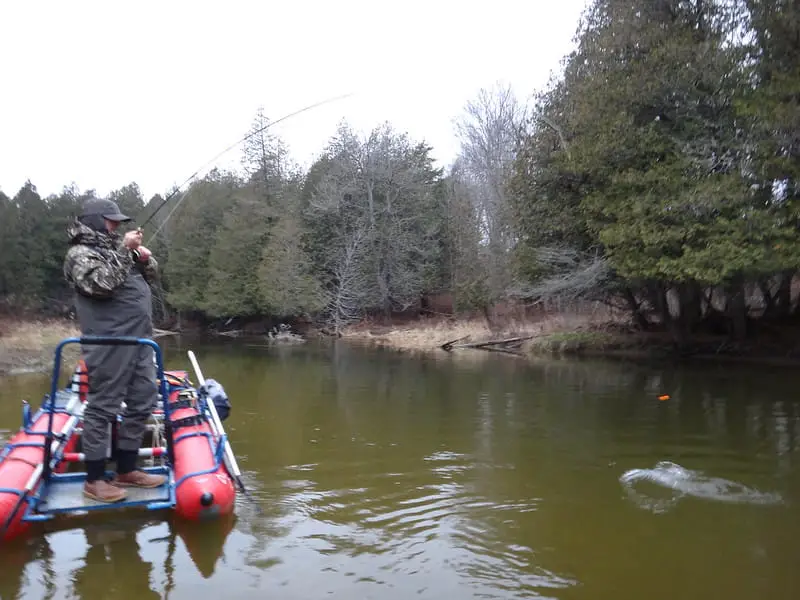
Indicator fishing is the number 1 method used by anglers that start nymphing for steelhead. It’s very popular and I say it’s the number one method, but that doesn’t mean it’s actually the best method.
Indicator nymphing is often used by most guides too simply because it’s easy to teach and use while still being effective in certain types of water. But, there is a better method which I will discuss below.
Indicator fishing for steelhead means that you are presenting your fly either by dragging it along the bottom below an indicator or you are suspending your fly below an indicator. One of these versions is proven to be much more effective.
I prefer to not use the old school method of dragging my fly under an indicator anymore because I believe it is less productive and comes with some unwanted problems that limit how many fish you will catch.
I prefer to use a method known as suspension nymphing which is when you suspend your fly up and off the bottom with the use of a floatation device known as an indicator and some weights known as split shots.
Using the suspension nymphing method for steelhead allows anglers to control their speed, and their angles which allows them to get a better presentation and more bites. Suspension nymphing also allows you to detect all those extra bites much better.
There are two ways to hold your float back and manage your indicator angles when suspension nymphing.
The first way which I use when fishing close and when fishing nervous trout is to use the high stick(high rod tip) method with no line on the water and then control the speed of the indicator by moving your rod tip downriver at the desired speed, it usually only takes a little bit of hold on the rod tip to slow the indicator and change the angle.
The other method is to stack mend or shoot mend the line directly above your indicator. With all the fly line mended directly upriver of the indicator, it will create extra line drag which will slow down the indicator. The trick is to make sure it’s not too slow or too fast.
If the indicator starts to move too fast, slowly pulling the line upriver will slow it down again. if the indicator is too slow I will mend some line downriver to take off the tension. Done right and you can make long drifts with some speed control.
Indicator nymphing in general is best done on bigger pools, riffles, and runs and in slower flat water. Indicator fishing is not great in smaller pockets or fast rapids.
Old School Indicator Method
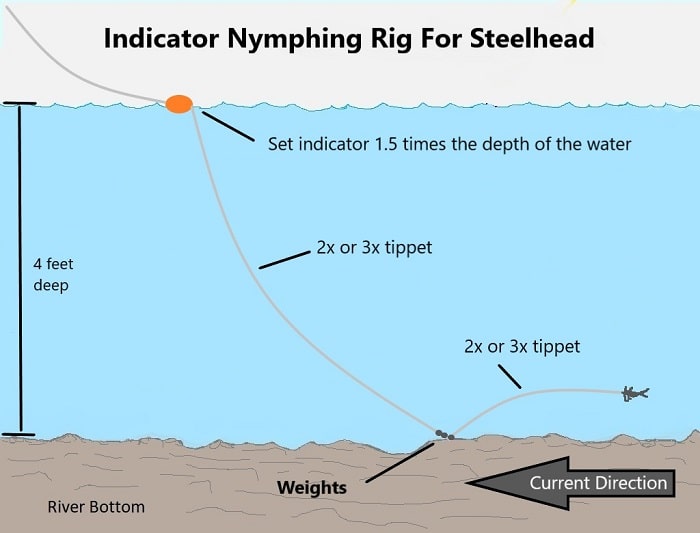
You may have heard people, and even guides tell you that you want to set your indicator at one and a half times the depth of the water that you are fishing. I’ve even heard people say 2 times the depth of the water that you are fishing.
That means if the spot you are fishing is 4 feet deep you want your leader below your indicator to be at least 6 feet deep
This long leader sometimes works but it’s an old method that needs to be revised.
This old-school mentality of 1.5 times the depth of the water was because the idea was that you want to get your bait to the bottom and because there is almost always some drag on your leader and the extra length helps you accommodate for the angle of the leader.
Many anglers also set up their leader like this because they want their weights to be occasionally bumping across the bottom to help them determine if their flies are deep enough.
Without getting too in-depth as to why this is a bad way of nymphing for steelhead, let me go over a few of the common problems with this method.
Your chances of having unseen slack in the line below the surface can cause you to miss bites are this problem is much higher with this method. With this method, you could have slack in the line between your indicator and your weights, or you could have slack in the line between your fly and your weights, or both!
If there is slack in the line anywhere between your fly and your indicator, the indicator will not go under until that slack is removed, and often by that time, the steelhead has already spit the fly out.
We have all heard that drag is bad, and that you have to even watch out for something called micro drag.
With this indicator setup, you are often dragging your flies behind the indicator most of the time and often without even knowing it, which will limit how many fish will actually bite your flies.
Guys, almost always, if your indicator is moving at the same speed as the bubbles or the same speed as the surface current, you ARE DRAGGING your flies. This can and will prevent some fish from grabbing your fly. I guarantee this!!
Also, because of the excess line that puts your weight on the bottom, you also risk being snagged on the bottom much more often or you will end up dragging your flies along the bottom and below the steelhead heads. If the fly is below their heads they are less likely to see it and grab it.
By dragging your weights and flies along the bottom you even risk damaging your tippet, which could cause you to break off a big steelhead.
There is a better way to use an indicator.
Suspension Nymphing For Steelhead: The Better Way
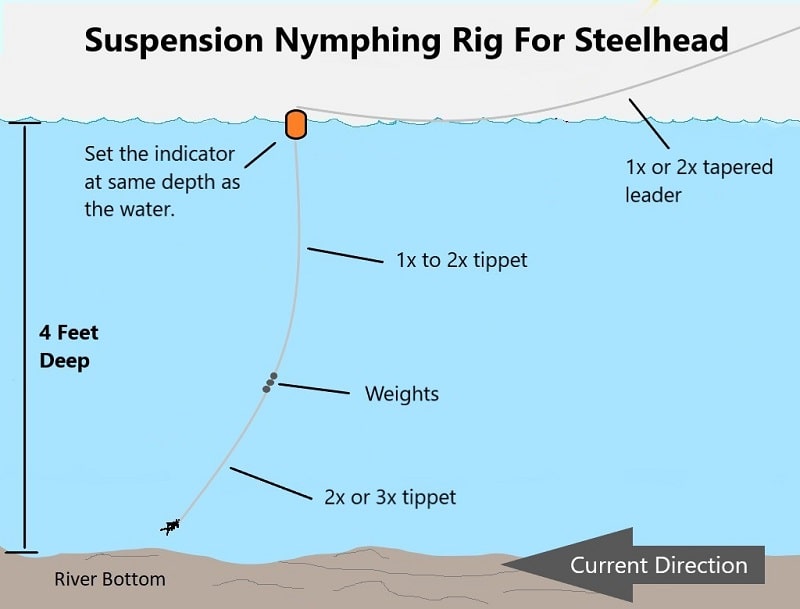
Some of you might already know this about me, along with fly fishing for about 37 years now, I have also been fishing with Centerpin and spinning reels while float fishing for steelhead for over 30 years. Doing so has made me a far better nymph angler and I will tell you why.
Most float fishing anglers and even fly anglers will tell you that Centerpin fishing or float fishing is far more productive than fly fishing. However, I don’t necessarily agree.
The simple reason that Centerpin fishing is often more productive is simply that most fly anglers don’t nymph fish well enough and they don’t control the speed of their bait effectively, and the Centerpin anglers do it much better.
The ability to slow your bait down and to keep all the drag off your bait is much easier to do when you are Centerpin fishing because there is little to no ling on the water causing drag.
Because of the way most fly anglers set up and fish their indicators, it makes controlling the speed of the fly difficult, and it makes strike detection more difficult, but it doesn’t need to be this way.
I have stood beside excellent Centerpin guys and caught as many or more fish than they have while I was nymphing. The simple reason I can do this is that I understand what my fly is doing below the water and I am very good at controlling the speed of my flies and keeping out all drag, even drag that most anglers don’t see.
Centerpin fishing for years has helped me do this exceptionally well with an indicator and any angler can do it too if they know how.
Using the suspension nymphing method is one of the best ways to control the speed of your flies while taking the drag out of the presentation, and improving your strike detection.
With suspension nymphing, you set your indicator at the depth of the water that you are fishing, or maybe even at add 6 to 12 inches more than the water you are fishing as long as your fly is not dragging the bottom. Ideally, you want your fly 6 to 12 inches off the bottom at all times.
Doing so keeps everything up and off the bottom and in the strike zone where the fish are feeding. You are basically suspending everything from the indicator and you stop dragging the bottom with your weights or your fly.
There is no weight being dragged across the bottom and there is no slack in the setup to prevent you from missing bites so now you can focus on mending your line to slow your indicator and your fly down.
In fact, the setup of suspension nymphing is similar to both the old school nymphing setup and the float fishing setup that Centerpin anglers use, it’s kind of a hybrid of the two.
The first and only time I have ever seen this suspension nymphing being written about or talked about was in a book called Dynamic Nymphing by the famous fly angler and competition fly fishing team member and team USA head coach, and author, George Daniel.
If you don’t have a copy of the Dynamic Nymphing book yet, you should. It’s one of the best modern nymphing books available and many of the methods and flies can be used for steelhead fishing.
Modern Must-Have Books For Nymphing:
- Dynamic Nymphing – George Daniel
- Nymph Fishing: New Angles, Tactics, and Techniques – George Daniel
- Tactical Fly Fishing: Lessons Learned from Competition for All Anglers – Devin Olsen
2 Fly Suspension Nymphing Rig For Steelhead
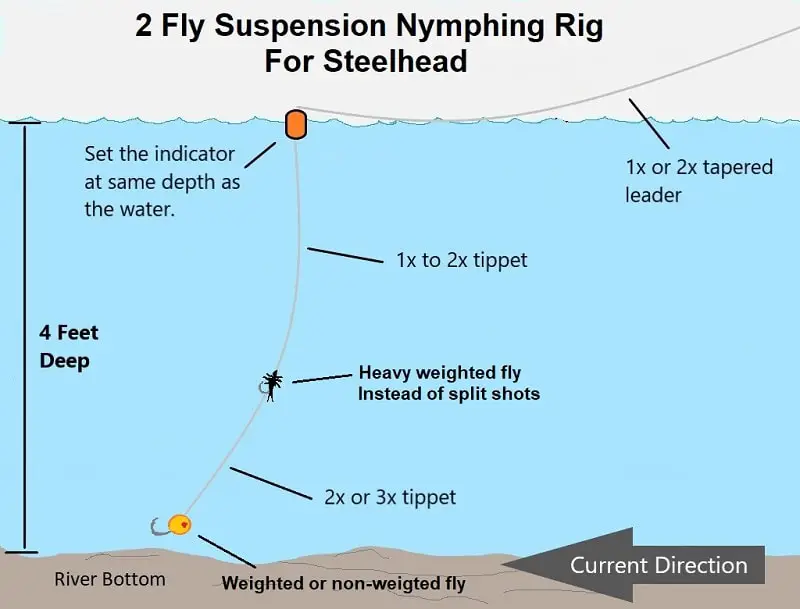
You can also use the suspension nymphing rig with two flies and no weights. (only use two flies where permitted by law) I actually use this two fly system more than the two fly rig above with the weights.
The idea is you are suspending both flies off the bottom as much as possible without them touching or dragging the bottom.
If possible, I want my bottom fly to be 6 to 12 inches suspended off the bottom at all times, and my top fly higher, but only high enough that the fish can also see it. I discuss how high below.
So in 4 feet of water, your entire leader length should be 3.5 feet to 4 feet long.
The type of flies that you use on the top or the bottom of this setup is up to you, however, at least one fly should be weighted to keep both of them down.
NOTE: If you do not have weighted flies get some, or just use split shots. If you have to use weights, use one or two split shots 6 to 12 inches above the top fly, and maybe a second single weight situated dead center between the two flies.
Ideally, it’s best NOT to use weights and only to use weighted flies.
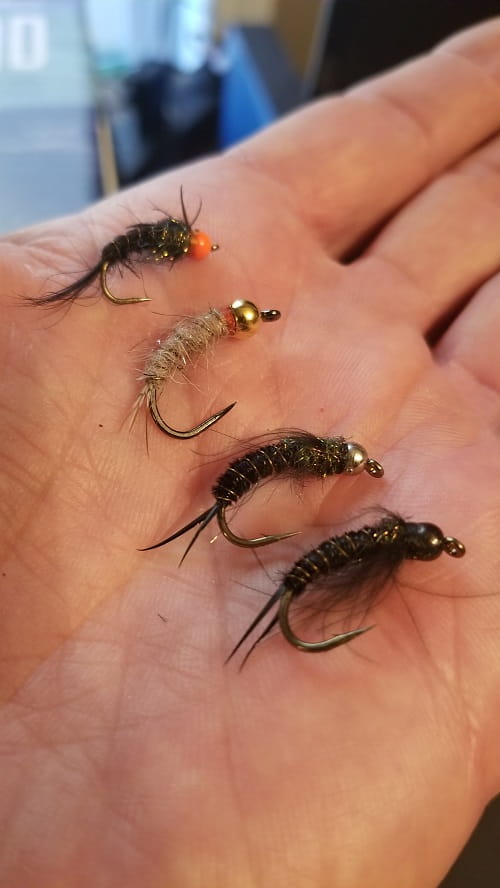
For the ideal two-fly suspension rig, I replace the weights as seen in the standard suspension nymphing diagram with a large and heavily weighted fly. This is the top fly in most situations.
My top flies usually have lead wrapped around the shank before I tie them and they are usually tied with a tungsten bead for extra weight.
I’ll use smaller flies with less weight when fishing slower or shallower water, or I use larger flies with more weight for faster deeper water.
I adjust one or both flies depending on the velocity and depth of my fishing spot. In very fast water I might put the heavy fly on the bottom or even use two weighted flies to be sure I’m getting down to the fish.
If the water is not very fast, more often I will use a heavy fly as the top fly and change the bottom fly size and weight accordingly, which means the size and weight that I need to keep the fly in the strike zone.
The bottom fly can also be a not weighted fly pattern like my San Juan worm or an egg pattern.
I use the heavier fly on top because it will pull the non-weighted fly down and since the non-weighted fly is not heavy it won’t drag and snag on the bottom as often. Two heavy flies will often snag too much, especially in slower water, and if you don’t have your depth set properly.
The distance between the two flies will depend on the conditions. The dirtier the water the closer I want those two flies because I want to be sure the fish sees them both. And, often, in dirty water, they will hold tight to the bottom. So if the water is 12 to 14 inches of visibility I will have my flies 6 to 14 inches apart.
NOTE: When I say visibility or clarity of the water, I’m referring to how much water I can see through. I determine that in two ways. Start from the river’s edge, and look to see how far out can you see the bottom before you almost lose sight of the bottom, then estimate how deep that is at that point.
Or, if I’m standing in the water and I can barely see the tops of my boots in 12 inches of water, I would consider that 12 to 14″ visibility.
So, in clearer water, I will increase the distance between my two flies according to the amount of clarity.
If one fly is 2 inches from the bottom in 36-inches of visibility, I’d separate my flies 24″ to 30″ because I know the fish should still be able to see that top fly, and both flies.
Having the flies spread apart at this distance has the advantage of you potentially and unknowingly dragging one fly across the bottom because it’s too deep (remember we are trying to suspend the flies) while having the top fly perfectly situated just over the fish’s heads.
You are not always going to be able to predict high spots or slightly suspended fish so having your flies 24 to even 36 inches apart can be very beneficial.
Attaching Your Flies For A two Fly Rig
When attaching the flies to this rig you have 3 options that work.
There are times when I am being lazy and I will attach the tippet section that goes to the bottom fly off the hook bend of the top fly.
The better option is to tie the bottom and top tippets from the same eye of the top fly. This will often make the fly ride more sideways and the hook will be out further from the line which is often better for hooking the fish.
Another option which I do a lot, especially when I am setting up a new leader for the first time is to leave a 6-inch dropper tag off the Tripple Surgeon’s knot and then I tie the top fly off the dropper tag. You can see this dropper tag set up on my page 2-Fly Nymphing Rigs.
Steelhead Leader Formula For Nymphing With An Indicator
My leader formula consists of the following items:
- Indicator
- 0X to 3X tapered Leader
- 1X to 3X tippet
- Tippet rings and micro swivels
- Split shots
- Flies
Steelhead Indicator Rig Diagram
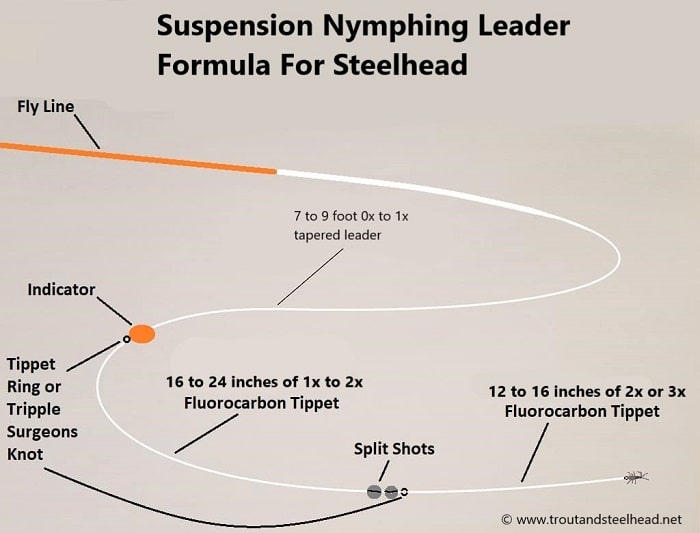
Best Indicator For Steelhead Fishing
The indicator that you use for either of these steelhead nymphing methods makes a difference. There are a bunch of indicators on the market and most are crap. It’s not that these crappy indicators don’t float well, or cast well, it’s just that I use my indicators for more than just strike detection.
A good strike indicator will help you control your speed, improve your leader angles, help you know where your fly is during the drift and it will help improve your strike detection.
If you want to catch more fish all of these things are important. You can see my favorite indicators on my page What Are The Best Indicators For Fly Fishing? Guides Advice.
Euro Nymphing For Steelhead
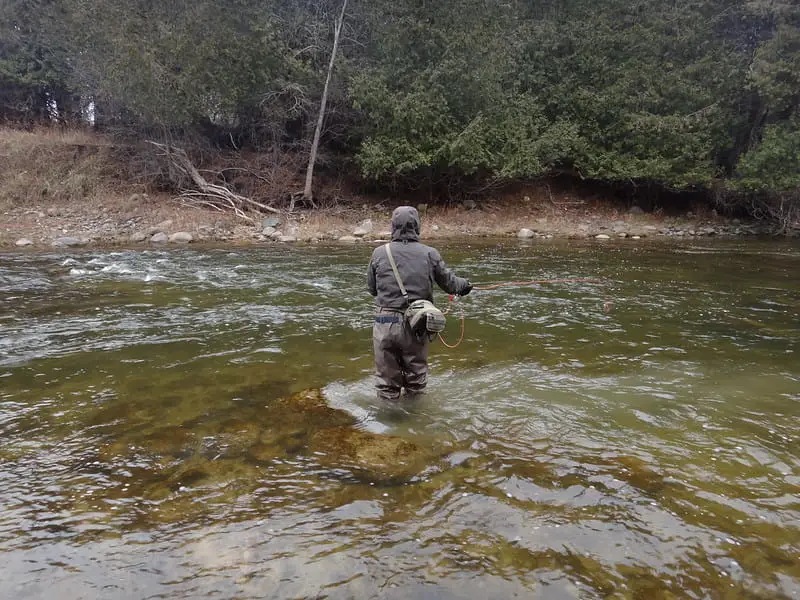
I told you I was going to discuss the two most effective methods for nymphing for steelhead. The first one is suspension nymphing, the second one is Euro Nymphing or as some anglers call it “tight line nymphing” or “modern nymphing”.
Euro nymphing is a relatively new way of nymph fishing for steelhead and if done correctly in the right type of water it is the most effective way to nymph for steelhead. In fact, I’ve yet to meet a guy that can outfish me with an indicator in certain types of water.
Euro nymphing excels in shallower water under 5 feet deep and in pocket water. Euro nymph fishing enables you to slow your flies down to get a more natural drift and it can’t be beaten for strike detection. Both of these things mean more steelhead in the net.
I Euro nymph for steelhead the exact same way that I Euro nymph for trout.
I go over everything you need to know about this very productive method on my page Euro Nymphing For Steelhead.
Best Steelhead Flies
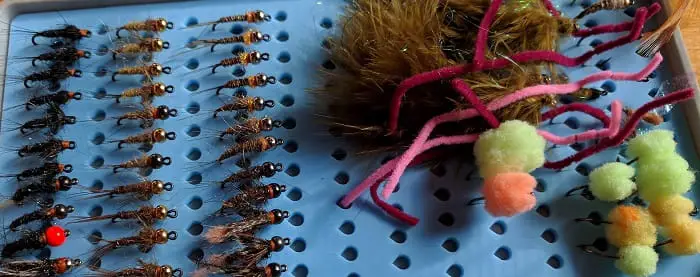
The flies that you use are an important part of steelhead nymphing. I discuss my best steelhead nymphs on my page Best Flies For Steelhead.
Got A Question About Nymphing For Steelhead
If you have a question, comment, or a tip about nymphing for steelhead let me know in the comments section below.
Tight Lines
Graham
